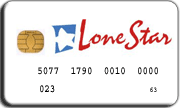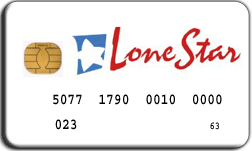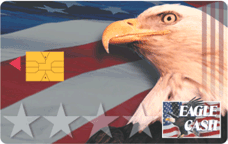Texas goes live with a smart card-based benefits card
25 January, 2006
category: Government, Library
 Speed, convenience and quicker reimbursement all add up to a successful launch of the WIC smart card program in Texas. WIC, a federal program begun in 1974, stands for Women, Infants and Children and provides participants with nutritious foods, counseling, and referrals to health and other social services at no charge. The program serves low-income pregnant, postpartum and breast-feeding women, and infants and children up to age 5 who are at nutrition risk.
Speed, convenience and quicker reimbursement all add up to a successful launch of the WIC smart card program in Texas. WIC, a federal program begun in 1974, stands for Women, Infants and Children and provides participants with nutritious foods, counseling, and referrals to health and other social services at no charge. The program serves low-income pregnant, postpartum and breast-feeding women, and infants and children up to age 5 who are at nutrition risk.
In most states, women are given WIC vouchers or checks that they redeem at grocery stores for WIC-eligible foods and beverages, such as milk and infant formula. But in Texas, all that is changing.
After a year-long pilot program in El Paso, the state’s Department of State Health Services (DSHS) is expanding the use of an electronic benefits smart card for purchases made by WIC clients, replacing the paper voucher system.
“The pilot went very well,” said Hank Lundberg, part of the DSHS Electronic Benefits Transfer Development project. Last October, the state began the gradual implementation of the WIC smart card program, issuing its Lone Star Card to women in the north central Texas area near Dallas. This same card is also used for food stamp and TANF (Temporary Assistance for Needy Families) recipients, he said.
“It will be an incremental expansion,” said Mr. Lundberg of the multi-year project. “We had to break this up into manageable pieces so stores can get ready.”
The smart card, produced by Gemplus and issued through First Data Government Solutions, contains a chip that stores food benefits data for all members of a household participating in the WIC program. “The card is loaded for each client at a WIC clinic,” Mr. Lundberg said.
 At the grocery store, the user inserts the card into a device at the register, where the card stays until the purchases are complete. “Computer systems of WIC-authorized grocers read the cards at a checkout terminal and match the information to items as they are scanned,” said Mr. Lundberg. Store computers identify WIC-approved items based on scanned product codes. When the WIC client is finished, she is prompted to remove her card.
At the grocery store, the user inserts the card into a device at the register, where the card stays until the purchases are complete. “Computer systems of WIC-authorized grocers read the cards at a checkout terminal and match the information to items as they are scanned,” said Mr. Lundberg. Store computers identify WIC-approved items based on scanned product codes. When the WIC client is finished, she is prompted to remove her card.
The items are deducted from the user’s card as the items are rung up. When the client comes through the lane, two transactions are actually conducted, one for the store and one for WIC, explained Mr. Lundberg. Those WIC transactions are then bundled “and sent to us electronically.”
Each card contains food benefit information covering three months, calculated on a month-by-month basis. As items are purchased, the card is automatically updated with the remaining balance.
Under the old system, WIC-eligible items had to be separated and totaled so the vouchers could be properly redeemed. This process took extra time at the cash register. No more.
“A huge benefit for the client is the ease in using the card,” said Mr. Lundberg. “Instead of carrying a big wad of paper (vouchers), they just have this one plastic card. In the past, if the client lost the vouchers, we had no mechanism to replace them, but if they lose the card, we now know what they’ve used and we are able to easily replace the card.”
Supermarkets love it too, not only for the time it saves a cashier, but because it reduces the time it takes for the store to be reimbursed for the WIC items. “With paper, it takes three to four weeks to get reimbursed,” said Mr. Lundberg. “With electronic transactions, redemptions occur in only three to four days.”
And the users? “They don’t want to go back to paper,” he said.
The new program “virtually eliminates fraud. Also, the cashier doesn’t have to think about whether it’s a WIC or non-WIC item,” he added.
Before the state even began its pilot program, it worked closely with retailers, making sure the system would work with the various cash register systems in use. “Let’s say the grocer users NCR or IBM systems. We worked with the grocers to make sure their ECR (electronic cash register) vendors could integrate the electronic benefits transfer (EBT) function into their software,” said Mr. Lundberg.
The program will also work for the small grocer who may not have the sophisticated electronic cash register capability of the chains. “We have an EBT-compatible device developed for the small operation,” he added. “We have three commercial vendors who have developed solutions for small grocers which does the same thing as the electronic cash register.”
That, he added, was one reason Texas’ program is more successful than pilots that started, and failed, in other states. “Many states were trying to set up a stand-aside solution where they had two systems running,” he said. “Cashiers had to scan twice and in a lot of cases that hasn’t worked very well.”
Another reason for the state’s success is the number of people who participated in the pilot program. “We had more participants covered in our pilot than in all the other states combined,” said Mr. Lundberg.
He said the state is “still working on final implementation dates. After we complete Collin County (near Dallas) next month, we’ll be expanding to west Texas, Midland-Odessa and just east of El Paso but south of the Panhandle. It’s a pretty large area and that expansion will start in June. In September we’ll be expanding into the Panhandle, Lubbock and Amarillo.”
Additional resources:
To visit the Texas WIC Card program on the web, click here.
To visit the USDA Food and Nutrition Service’s WIC EBT study online, click here.




